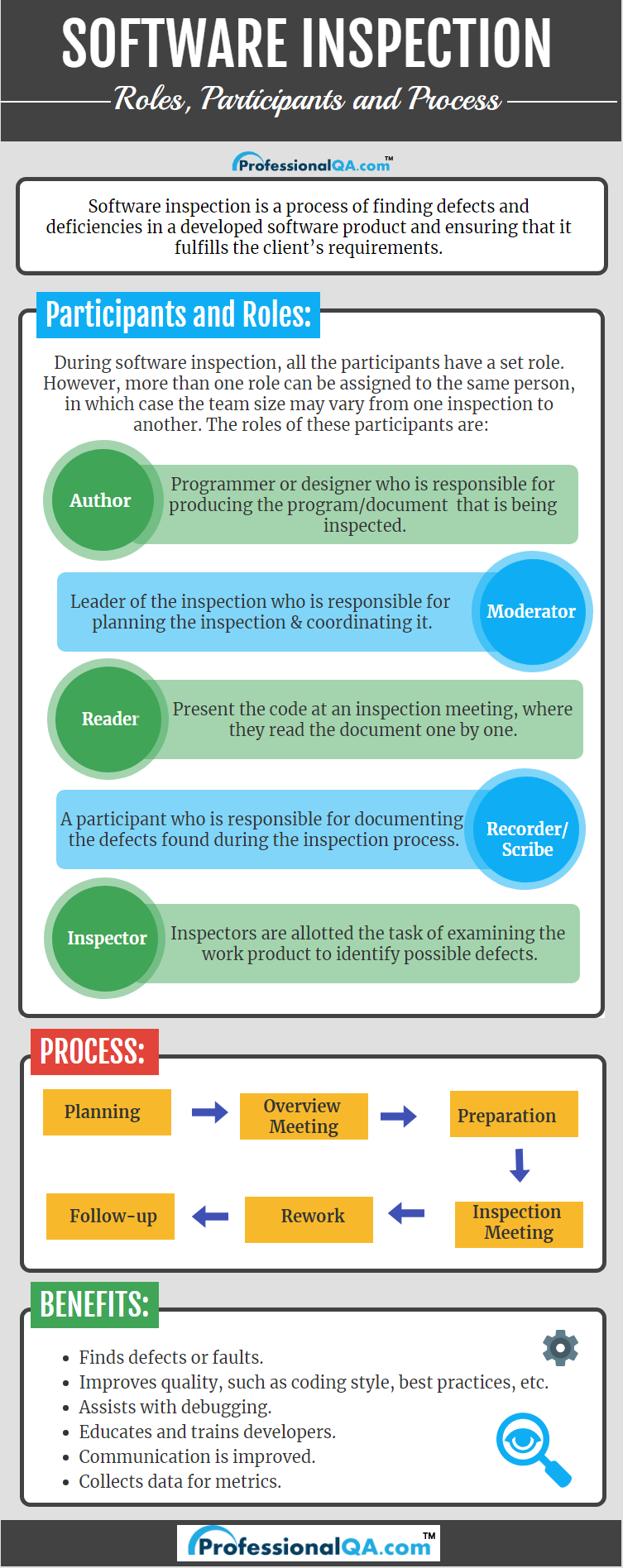

Errors and mistakes are common occurrences in the software development process. Throughout the Software Development Life Cycle (SDLC), developers and testers come across innumerable errors, defects, bugs and other discrepancies, which if left undetected and unresolved can harm the functionality and performance of the software.
Moreover, any complexities found in the code can become a greater hurdle, as it prevents developers from getting software’s intended results. Therefore, to overcome these discrepancies and errors, both software practitioners and researchers need to improve the reputation of the software.
The best way to do this is through inspection, which is the only way to improve the quality as well as performance of a software. This method of software inspection can be extremely effective, however its success depends on having a complete and systematic procedure for conducting the inspection. Hence, here is an elaborated discussion on Software Inspection and its process, role and participants, which will help you get the best software inspection results.
Software inspection refers to peer review of a product, in which the focus is on identifying all its defects and errors. Named after Michael Fagan, the creator of a popular software inspection process, Software Inspection is also known as ‘Fagan inspection’.
With its assistance one can find defects and deficiencies in a developed software product and ensure that it is fulfilling client’s requirements. Software inspections can be applied in every software development phase and is commonly used to inspect software requirements specification and test plans. Due to the fact that inspections can be applied early in the development process, quality problems can be found and corrected directly where they have been introduced. Moreover, inspections shorten delivery period by reducing the time spent in the integration and system test/debug phases.
In an inspection, a work product is selected for review by a team of experts, who are gathered for an inspection meeting to review the work product. Furthermore, a moderator is chosen to moderate the meeting, where inspectors prepare for the meeting by reading the work product and noting each defect. In short, in an inspection, a defect is any part of the work product that keeps an inspector from approving it.

During software inspection, the number of participants range from a minimum of three to a maximum of six. The minimum number of participants is derived from the required roles that are assigned to each individual. Having more than six participants does not increase the number of defects uncovered, but it does increases the cost of effectiveness. In short, having more than six participants during inspection increases the cost per defect discovered to unacceptable levels.
The participants in software inspection have a set role, however the same person can take more than one role, so the team size may vary from one inspection to another. The various roles of these participants are:
The quality of a software product depends largely on the quality of the process that is used to develop it. Software inspection is a proven method for improving product quality and it provides a very cost effective way for organisations to improve their development processes. The process of software inspection is a formal one and is carried out by a team of at least four to five people. Each of these individuals play an important role in the whole process and ensure the quality and effectiveness of the product is prodigious. Hence the process of software inspection is as follows:
Software inspection is a very crucial phase of software development cycle, which assists testers in detecting all the discrepancies in the software. By performing inspection on the developing software, testers and developers can ensure its quality and functionality. The main benefit of software inspection is that it can be applied early in the software development process. Moreover, it will help testers in validating whether the software is developed as per the client’s demand or not. Other benefits of software inspection are:
Inspecting a software for errors and defects is the most sensible way of ensuring a products quality and productiveness. Inspection not only validates software’s effectiveness, but also saves ample time, effort, and cost that would have been spent in resolving issues and doing rework. With the assistance of this formal process, software developers can develop a software, while making sure that each and every phase of development is inspected properly and that no defects or discrepancies are left undetected by the testers and developers.
From code base errors to defects found before the product release, all discrepancies can be monitored and resolved through proper inspection. The biggest advantage of inspection is that, it can be applied during the early stages of Software Development Life Cycle (SDLC), which allows developers to detect defects as soon as possible. All these factors and advantages have made peer review a valuable part of software engineering practice and has made inspection a crucial stage of Software Development Life Cycle (SDLC).
Advertisement: